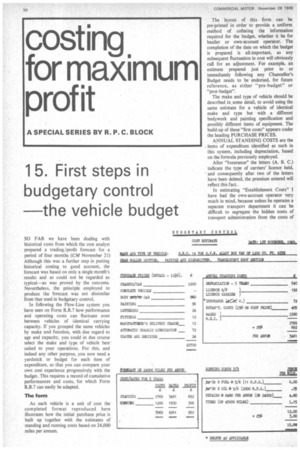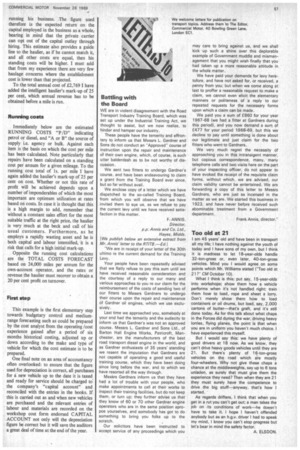15. First steps in budgetary control the vehicle budget
Page 58

Page 59

If you've noticed an error in this article please click here to report it so we can fix it.
SO FAR we have been dealing with historical costs from which the cost analyst prepared a trading /profit forecast for a period of four months (CM November 21) Although this was a further step in putting historical costing to good account, the forecast was based on only a single month's results and so could not be regarded as typical—as was proved by the outcome. Nevertheless, the principle employed to produce the forecast was not dissimilar from that used in budgetary control.
In following the Flow-Line system you have seen on Form R.B.7 how performance and operating costs can fluctuate even between vehicles of identical carrying capacity. If you grouped the same vehicles by make and function, with due regard to age and capacity, you could in due course select the make and type of vehicle best suited to your operations. For this, and indeed any other purpose, you now need a yardstick or budget for each item of expenditure, so that you can compare your own cost experience progressively with the budget. This requires a record of cumulative performances and costs, for which Form R.B.7 can easily be adapted.
The fonn
As each vehicle is a unit of cost the completed format reproduced here illustrates how the initial purchase price is built up together with the estimates of standing and running costs based on 24,000 miles per annum. The layout of this form can be pre-printed in order to provide a uniform method of collating the information required for the budget, whether it be for haulier or own-account operator. The completion of the date on which the budget is prepared is all-important, as any subsequent fluctuation in cost will obviously call for an adjustment. For example, an estimate prepared just prior to or immediately following any Chancellor's Budget needs to be endorsed, for future reference, as either "pre-budget" or "post-budget".
The make and type of vehicle should be described in• some detail, to avoid using the
same estimate for a vehicle of identical make and type but with . a different bodywork and painting specification and possibly different items of equipment. The build-up of these "first costs" appears under the heading PURCHASE PRICES. ANNUAL STANDING COSTS are the . items of expenditure identified as such in this system, including depreciation, based on the formula previously employed.
After "Insurance" the letters (A. B. C.) indicate the type of carriers' licence held, • and consequently after two of the letters have been deleted, the premium entered will reflect this fact.
In estimating "Establishment Costs" I have had the own-account operator very much in mind, because unless he operates a separate transport department it can be difficult to segregate the hidden costs of transport administration from the costs of
running his business. The figure used therefore is the expected return on the capital employed in the business as a whole, bearing in mind that the private carder can opt out of the capital outlay through hiring. This estimate also provides a guide line to the haulier, as if he cannot match it, and all other costs are equal, then his standing costs will be higher. I must add that from my experience there are very few haulage concerns where the establishment cost is lower than that projected.
To the total annual cost of £2,769 I have added the intelligent haulier's mark-up of 25 per cent, which annual revenue has to be obtained before a mile is run.
Running costs Immediately below are the estimated RUNNING COSTS "P/D" indicating petrol or diesel, and "A or B" the source of supply i.e. agency or bulk. Against each item is the basis on which the cost per mile has been calculated. Note particularly that repairs have been calculated on a standing cost per annum for a given mileage. To the running cost total of is. per mile I have again added the haulier's mark-up of 25 per cent on cost. Whether or not this rate of profit will be achieved depends upon a number of imponderables of which the most important are optimum utilization at rates based on costs. In case it is thought that this is a high margin to add, remember that without a constant sales effort for the most suitable traffic at the right price, the haulier is very much at the beck and call of his usual customers. Furthermore, as he employs a rapidly wasting asset and he is both capital and labour intensified, it is a risk that calls for a high initial mark-up.
Opposite the running cost calculations are the TOTAL COSTS FORECAST based on 24,000 miles per annum for the own-account operator, and the rates or revenue the haulier must recover to obtain a 20 per cent profit on turnover.
First step This example is the first elementary step towards budgetary control and mediumrange forecasting such as could be prepared by the cost analyst from the operating /cost experience gained after a period of six months historical costing, adjusted up or down according to the make and type of vehicle for which the cost estimate is to be prepared.
One final note on an area of accountancy often overlooked: to ensure that the figure used for depreciation is correct, all purchases for a. new vehicle up to the date it is taxed. and ready for service should be charged to' the company's "capital account" and reconciled with the entries in the books. If this is carried out as and when new vehicles are purchased and the relevant entries of labour and materials are recorded on the workshop cost form endorsed CAPITAL ACCOUNT not only will the depreciation figure be correct but it will save the auditors a great deal of time at the end of the year.
















































































































